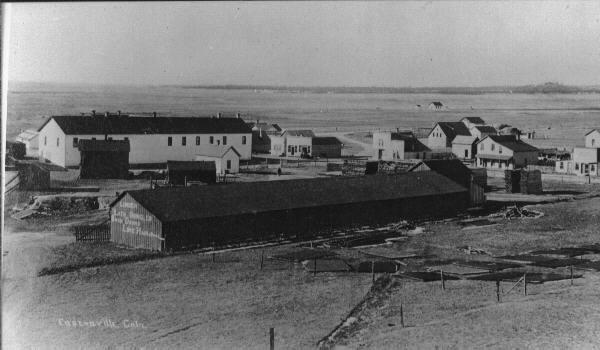
With the establishment of Eastonville just three miles to the southeast of Fagan's grave, the prophecies of the agrarian gold seekers were fulfilled. As the town grew so too did he number of surrounding farms and ranches. The Ayer ranch had already been started on Black Squirrel Creek in 1876; others soon followed. Dryland farming began to produce good yields of alfalfa, wheat, oats and potatoes. The planting of potatoes became so widespread that the town began to call itself "the Potato Capitol of the World." At harvest time entire freight trains were sidetracked and filled to overflowing. Two-pound potatoes were not uncommon during the anuual potato bakes. A factory was established to manufacture Bradshaw's Potato Sorter, a horse-drawn machine that sorted and shook the potatoes into separate sacks according to size.
By the 1930's a severe blight began to cripple the potato industry. Eastonville - which had once boasted a population of over 300, with three blacksmith shops, three hotels, three churches, a livery, a bakery, and several other businesses - began to lose its population. The town deteriorated slowly until 1935, when the great flood took out part of the railroad. After the damaged racks were taken up, the remaining families gradually moved away.(3)
The Eastonville of today is a ghost town. Nothing remains but one dilapidated house and a few foundations of concrete and rock that still hug the eroding railroad bed. The potato farms have long since reverted to prairie. The sawmills have been closed down. Many of the ranches have been turned into subdivisions, as sprawling suburbia from the south slowly encroaches upon Black Forest. In the valley that heads West Kiowa Creek construction has begun on several new houses. Mailboxes now stand where once anelope grazed. New roads are being carvd through the prairies grasses and new bridges span the creeks.
Only Fagan's grave remains undisturbed.
FOOTNOTES -
(1)- Kerr, J.H. Papers, Vol.5, p.120. Colorado Springs Pioneers Museum.
(2)- Cragin, F.W. Papers. XVII, 3. Colorado Springs Pioners Museum.
(3)- Much of this information on Eastonville comes from Hobbs, Charle M. "Eastonville in 1886," Palmer Lake-Monument News, 29 April 1971.